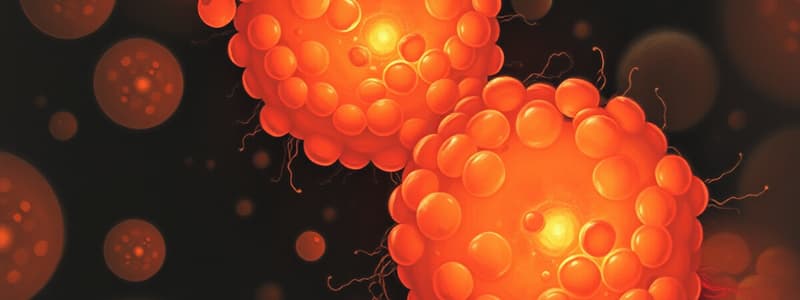Podcast
Questions and Answers
What type of vesicles may fuse with lysosomes to break down materials?
What type of vesicles may fuse with lysosomes to break down materials?
Where are ribosomal components produced within a cell?
Where are ribosomal components produced within a cell?
Which of the following statements accurately describes the role of ribosomes?
Which of the following statements accurately describes the role of ribosomes?
What is the function of peroxisomes in a cell?
What is the function of peroxisomes in a cell?
Signup and view all the answers
Which component of the cell is primarily responsible for the modification and packaging of proteins?
Which component of the cell is primarily responsible for the modification and packaging of proteins?
Signup and view all the answers
What is the primary role of the Golgi apparatus in a cell?
What is the primary role of the Golgi apparatus in a cell?
Signup and view all the answers
What substance primarily composes the nuclear membrane?
What substance primarily composes the nuclear membrane?
Signup and view all the answers
What do the nucleoli within the nucleus primarily contain?
What do the nucleoli within the nucleus primarily contain?
Signup and view all the answers
What is the function of lysosomes within a cell?
What is the function of lysosomes within a cell?
Signup and view all the answers
During which phase do chromosomes become tightly coiled and visible under a microscope?
During which phase do chromosomes become tightly coiled and visible under a microscope?
Signup and view all the answers
Study Notes
Cell Organelles and Functions
- Endocytotic vesicles can fuse with lysosomes to break down their contents.
- Ribosomes are produced in the nucleolus and are the sites of protein synthesis.
- Ribosomes can be free-floating or attached to the endoplasmic reticulum (ER).
- Peroxisomes are small vesicles containing enzymes for breaking down harmful substances, such as hydrogen peroxide, which can be toxic to cells.
- The endoplasmic reticulum (ER) consists of a series of membranes forming sacs and tubules extending from the nuclear membrane into the cytoplasm.
Nucleus Structure
- The nucleus is surrounded by a double membrane called the nuclear envelope, which has an outer and inner membrane with a narrow perinuclear space.
- The nuclear membrane contains nuclear pores that control the passage of materials in and out of the nucleus.
- Human cell nuclei contain several pairs of chromosomes, composed of DNA and proteins, existing loosely during interphase as chromatin and becoming coiled during cell division.
- The nucleus contains one or more nucleoli, which are non-membrane-bound structures involved in ribosome production.
Golgi Apparatus
- Also known as the Golgi complex, it consists of closely packed, curved, membrane-bound sacs.
- The Golgi apparatus functions in processing and packaging proteins and lipids, forming vesicles for transport.
Lysosomes
- Lysosomes are membrane-bound vesicles containing digestive enzymes that function as intracellular digestive systems.
- They are formed from the fusion of vesicles containing enzymes and materials to be broken down.
Cytoskeletal Elements
- Microfilaments are small protein fibrils that provide structural support to the cytoplasm and contribute to cell shape and movement, particularly in muscle cells.
- Intermediate filaments are larger than microfilaments and smaller than microtubules, providing additional structural support to the cell.
Mitochondria
- Mitochondria are organelles responsible for producing ATP through aerobic metabolism, with inner and outer membranes separated by an intermembrane space.
- The inner membrane contains enzymes and mitochondrial DNA (mtDNA), and cells requiring high energy have more mitochondria.
Studying That Suits You
Use AI to generate personalized quizzes and flashcards to suit your learning preferences.
Related Documents
Description
This quiz explores the roles of ribosomes in cellular functions and the process of endocytosis. It covers how vesicles can fuse with lysosomes to break down materials and the production of ribosome components. Test your understanding of these fundamental cellular processes.



